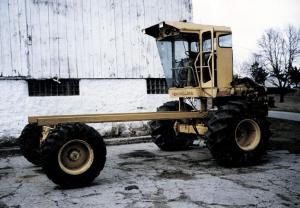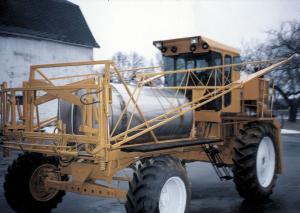State-Of-The-Art Combine Sprayer Saves $60,000 To $70,000
When Ken Soda checked out the cost of a new 4-wheel drive self-propelled sprayer a few years ago, he decided his 1,200 acres of cropland wouldn't cash flow the rig. So he enlisted his sons, Kevin and Steve, to help him build one. A few months and about $15,000 later, the Princeton, Wisconsin farmers had a 4-wheel drive sprayer with a 60-ft. boom, complete with foam markers. A Raven monitor, that by itself cost $3,300, completed the package. Overall, Soda figures he saved $60,000 to $70,000 over the price of a comparable commercial unit.
No stranger to home-built units, Soda and his sons knew what they wanted. They looked for and found a New Holland 75 combine. Several things drew them to the New Holland, recalls Soda.
"The cab was nice and roomy," he says. "Also, we wanted something that was center-mounted. Comparable Deere combines have cabs mounted to the side. Also, the New Holland had the same hydrostatic drive as the 6620 Deere, but it was cheaper. Green paint always costs more."
Soda pulled off the engine, fuel tank, lights, hydrostatic drive, front and back axles and wheels, as well as the cab and hydraulic units. Most everything else was scrapped out. The new sprayer was then designed from the ground up, beginning with two 20-ft., 3/8-in. thick, 4 by 6-in. box beams. The combine's optional drive rear axle was attached to the front of the beams to lead and steer like a tractor with the main drive axle attached at the rear. The 28L drive wheels were replaced with narrower and higher 18 by 42's for easier travel between the rows.
The cab was repositioned at the rear of the unit over the diesel fuel tank, but just ahead of the 3208 Caterpillar engine. A new 1,000-gal. stainless steel tank was mounted in front of the cab with the new 60-ft. boom ahead of that. The hydraulic unit that previously lifted the header was installed to drive the pump. Soda revised the drive pulley so it would run directly off the engine and to the axle below the engine.
Catwalks were mounted on each side of the tank and new ladders built and mounted for ease of access from the rear or front of the unit. A sheet metal cover, heavy-duty enough so it can be walked on if necessary, was mounted over the engine. The high power lights from the combine were retained and remounted for night work.
Contact: FARM SHOW Followup, Ken Soda, 10928 County Road J, Princeton, Wis. (ph 920 295-3171).

Click here to download page story appeared in.
Click here to read entire issue
State-Of-The-Art Combine Sprayer Saves $60,000 To $70,000 SPRAYING New Sprayers 24-5-12 When Ken Soda checked out the cost of a new 4-wheel drive self-propelled sprayer a few years ago, he decided his 1,200 acres of cropland wouldn't cash flow the rig. So he enlisted his sons, Kevin and Steve, to help him build one. A few months and about $15,000 later, the Princeton, Wisconsin farmers had a 4-wheel drive sprayer with a 60-ft. boom, complete with foam markers. A Raven monitor, that by itself cost $3,300, completed the package. Overall, Soda figures he saved $60,000 to $70,000 over the price of a comparable commercial unit.
No stranger to home-built units, Soda and his sons knew what they wanted. They looked for and found a New Holland 75 combine. Several things drew them to the New Holland, recalls Soda.
"The cab was nice and roomy," he says. "Also, we wanted something that was center-mounted. Comparable Deere combines have cabs mounted to the side. Also, the New Holland had the same hydrostatic drive as the 6620 Deere, but it was cheaper. Green paint always costs more."
Soda pulled off the engine, fuel tank, lights, hydrostatic drive, front and back axles and wheels, as well as the cab and hydraulic units. Most everything else was scrapped out. The new sprayer was then designed from the ground up, beginning with two 20-ft., 3/8-in. thick, 4 by 6-in. box beams. The combine's optional drive rear axle was attached to the front of the beams to lead and steer like a tractor with the main drive axle attached at the rear. The 28L drive wheels were replaced with narrower and higher 18 by 42's for easier travel between the rows.
The cab was repositioned at the rear of the unit over the diesel fuel tank, but just ahead of the 3208 Caterpillar engine. A new 1,000-gal. stainless steel tank was mounted in front of the cab with the new 60-ft. boom ahead of that. The hydraulic unit that previously lifted the header was installed to drive the pump. Soda revised the drive pulley so it would run directly off the engine and to the axle below the engine.
Catwalks were mounted on each side of the tank and new ladders built and mounted for ease of access from the rear or front of the unit. A sheet metal cover, heavy-duty enough so it can be walked on if necessary, was mounted over the engine. The high power lights from the combine were retained and remounted for night work.
Contact: FARM SHOW Followup, Ken Soda, 10928 County Road J, Princeton, Wis. (ph 920 295-3171).
To read the rest of this story, download this issue below or click
here to register with your account number.








